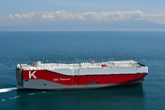Out of the clear blue sky
Published by Will Owen,
Editor
LNG Industry,
With the current global market for LNG growing each day, the oil and gas industry faces a challenge: how can LNG operators become more efficient, so they are able to profitably meet the rising demand of their customers?
A new solution arrives from the sky. In line with the heritage to convert well-proven jet engines to gas turbines for mechanical applications, Baker Hughes, a GE company (BHGE), in collaboration with GE Aviation, is moving forward with the development of its most recent and significant milestone, the aeroderivative gas turbine LM9000.
Developed by BHGE Nuovo Pignone in Italy acting as original equipment manufacturer (OEM), and as a result of a close collaboration with GE Aviation, the LM9000 will provide a new driver specifically designed for the needs of the LNG production.
LNG demand and costs rise
It is becoming prohibitively expensive to compress LNG. LNG compression must reach a certain cost level in order to be profitable.
The cost of compression is not the only expense for LNG producers. Space on offshore platforms and ocean-going vessels is also at a premium. Both factors are critical to quality in the LNG industry and solutions, so far, have been limited in scope without alleviating costs. Along with demand, LNG users clearly see the future challenge of CAPEX and OPEX and the total cost of ownership rising.
The solution exists in selecting the right driver – in this case, the right turbine. The LM9000 evolved from the proven power, endurance and uptime of the GE90 jet engine, operating on Boeing 777 aircraft since the GE90’s first flight in November 1995. Today’s GE90 engines maintain a reliability score of 99.98% over 50 million hr of flight, and the LM9000 follows in its performance.
Early in the design and development of the LM9000 (Figure 1), engineers considered the trade-offs between potential architectural configurations and the capabilities of the technology and selected the most appropriate option based on the GE90-115B, which offered greater flexibility to execute large LNG projects.
Reliability is driven by the core of the GE90-115B. LNG operators and users alike understand the critical need to achieve maximum compression while acknowledging the rising price of that essential component. The LM9000 will dedicate its primary application to maintaining land-based and ocean-going LNG installations around the world.
Designed specifically to fit the LNG application, the turbine will provide excellent performance under the most extreme conditions, able to withstand the harshest and most hazardous environments on and offshore.
The LM9000 is powered by a DLE dual-fuel capability that yields low emissions at 15 ppms. The power-to-size ratio of the LM9000 will deliver 67 MW with 43% simple-cycle efficiency in a small package measuring 13.5 x 5 x 4.5 m.
The design of the LM9000 utilises free-power turbine architecture with a unit that provides high efficiency, generating enough power to start in a fully pressurised condition, saving time and cost. The free-power turbine enables the unit to operate over a wide range of speed settings from 2400 rpm to 3870 rpm with virtually unaffected power and efficiency, making it one of the most competitive gas turbines on the market. The free-power turbine also allows 50 Hz and 60 Hz power generation without needing a gearbox.
The companion mini-skid will allow easy removal and swap of either the turbine’s supercore or the entire unit as needed for a quick repair turnaround in 24 hr, with a 50% increase of meantime between maintenance intervals versus current aeroderivative technology – the longest in the industry.
This is an abridged version of an article written by Maurizio Ciofini, Baker Hughes, a GE company, Italy, for the December 2018 issue of LNG Industry. To read the full version, click here.
Read the article online at: https://www.lngindustry.com/liquid-natural-gas/24122018/out-of-the-clear-blue-sky/
You might also like
‘K’ Line receives LNG-fuelled car carrier
An LNG-fuelled car carrier with a capacity of 6900 vehicles has been delivered to Kawasaki Kisen Kaisha, Ltd.

